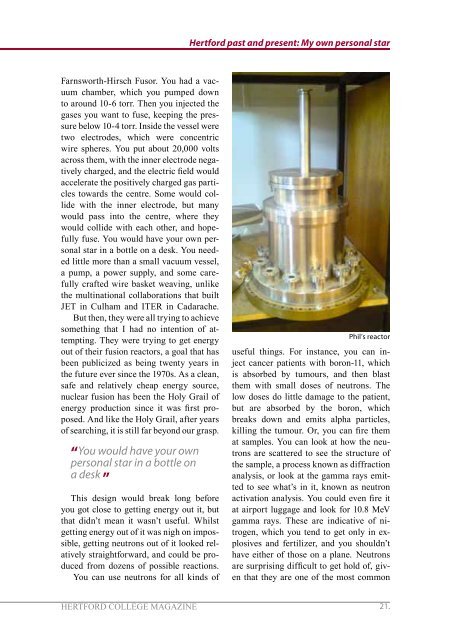2011 Hertford College Magazine (Issue 91)
2011 Hertford College Magazine (Issue 91)
2011 Hertford College Magazine (Issue 91)
Create successful ePaper yourself
Turn your PDF publications into a flip-book with our unique Google optimized e-Paper software.
Farnsworth-Hirsch Fusor. You had a vacuum<br />
chamber, which you pumped down<br />
to around 10-6 torr. Then you injected the<br />
gases you want to fuse, keeping the pressure<br />
below 10-4 torr. Inside the vessel were<br />
two electrodes, which were concentric<br />
wire spheres. You put about 20,000 volts<br />
across them, with the inner electrode negatively<br />
charged, and the electric field would<br />
accelerate the positively charged gas particles<br />
towards the centre. Some would collide<br />
with the inner electrode, but many<br />
would pass into the centre, where they<br />
would collide with each other, and hopefully<br />
fuse. You would have your own personal<br />
star in a bottle on a desk. You needed<br />
little more than a small vacuum vessel,<br />
a pump, a power supply, and some carefully<br />
crafted wire basket weaving, unlike<br />
the multinational collaborations that built<br />
JET in Culham and ITER in Cadarache.<br />
But then, they were all trying to achieve<br />
something that I had no intention of attempting.<br />
They were trying to get energy<br />
out of their fusion reactors, a goal that has<br />
been publicized as being twenty years in<br />
the future ever since the 1970s. As a clean,<br />
safe and relatively cheap energy source,<br />
nuclear fusion has been the Holy Grail of<br />
energy production since it was first proposed.<br />
And like the Holy Grail, after years<br />
of searching, it is still far beyond our grasp.<br />
“ You would have your own<br />
personal star in a bottle on<br />
a desk ”<br />
This design would break long before<br />
you got close to getting energy out it, but<br />
that didn’t mean it wasn’t useful. Whilst<br />
getting energy out of it was nigh on impossible,<br />
getting neutrons out of it looked relatively<br />
straightforward, and could be produced<br />
from dozens of possible reactions.<br />
You can use neutrons for all kinds of<br />
HERTFORD COLLEGE MAGAZINE<br />
<strong>Hertford</strong> past and present: My own personal star<br />
Phil’s reactor<br />
useful things. For instance, you can inject<br />
cancer patients with boron-11, which<br />
is absorbed by tumours, and then blast<br />
them with small doses of neutrons. The<br />
low doses do little damage to the patient,<br />
but are absorbed by the boron, which<br />
breaks down and emits alpha particles,<br />
killing the tumour. Or, you can fire them<br />
at samples. You can look at how the neutrons<br />
are scattered to see the structure of<br />
the sample, a process known as diffraction<br />
analysis, or look at the gamma rays emitted<br />
to see what’s in it, known as neutron<br />
activation analysis. You could even fire it<br />
at airport luggage and look for 10.8 MeV<br />
gamma rays. These are indicative of nitrogen,<br />
which you tend to get only in explosives<br />
and fertilizer, and you shouldn’t<br />
have either of those on a plane. Neutrons<br />
are surprising difficult to get hold of, given<br />
that they are one of the most common<br />
21.




